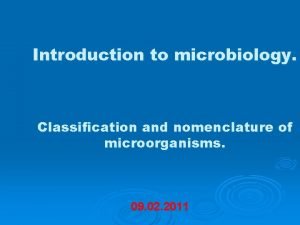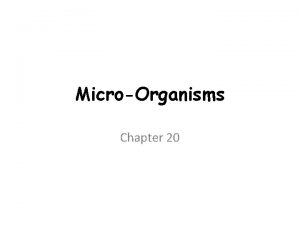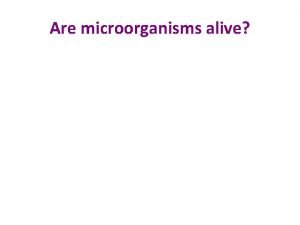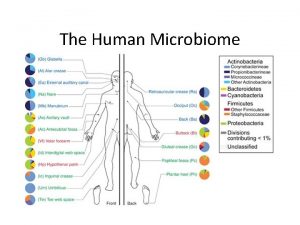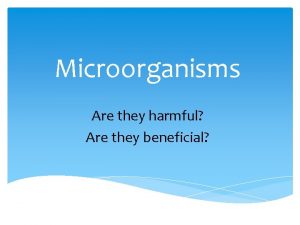Microorganisms Microorganisms The study of microorganisms is called








- Slides: 8

Microorganisms

Microorganisms • The study of microorganisms is called – microbiology • Someone who studies microbiology is called a microbiologist • To study microbiology, microscopes are needed since microorganisms cannot be seen with the naked eye.

Prokaryotic/Eukaryotic • So far we have been dealing with Eukaryotic cells… • Lets us look at the differences: - (video)

Fungi • Fungi is a eukaryotic cell based organism • The Kingdom Fungi includes some of the most important organisms • Some break down dead organic material, they continue the cycle of nutrients through ecosystems. • most vascular plants could not grow without the symbiotic fungi that inhabit their roots and supply essential nutrients. • Other fungi provide numerous drugs (such as penicillin and other antibiotics), foods like mushrooms, truffles and morels, and the bubbles in bread, champagne, and beer. • Fungi also cause a number of plant and animal diseases: in humans, ringworm, athlete's foot, and several more serious diseases are caused by fungi. • Because fungi are more chemically and genetically similar to animals than other organisms, this makes fungal diseases very difficult to treat. Plant diseases caused by fungi include rusts, smuts, and leaf, root, and stem rots, and may cause severe damage to crops. • However, a number of fungi, in particular the yeasts, are important "model organisms" for studying problems in genetics and molecular biology.

Bacteria though are prokaryotic • • Bacteria have : basal body - A structure that anchors the base of the flagellum and allows it to rotate. capsule - A layer on the outside of the cell wall. Most but not all bacteria have a capsule. cell wall - A thin membrane located outside the plasma membrane and within the capsule. DNA - The genetic material of the bacterium; it is located within the cytoplasm - The jellylike material inside the plasma membrane in which the genetic material and ribosomes are located. flagellum - A long whip-like structure used for locomotion (movement). Some bacteria have more than one flagellum. pili - (singular is pilus) Hair-like projections that allow bacterial cells to stick to surfaces and transfer DNA to one another. plasma membrane - A permeable membrane located within the cell wall. It serves many functions for the cell, including energy generation and transport of chemicals. ribosomes - Small organelles composed of RNA-rich granules that are sites of protein synthesis. The ribosomes are located within the cytoplasm.

Bacteria cont’d. • There are many different types of bacteria. Some bacteria are rod-shaped (these are called bacilli), some are round (called cocci, like streptococcus bacteria), and some are spiral-shaped (spirilli) or are incomplete spirals. • Some bacteria need atmospheric oxygen to live (these are called aerobic bacteria), but others do not (these are called anaerobic bacteria; they get their oxygen from other molecular compounds). • Another way to classify bacteria is by whether or not the bacteria absorbs a dye called "Gram stain" (a violet dye named for its developer, the bacteriologist Christian Gram). Gram positive and Gram negative bacteria have a different type of cell wall, and therefore, a different reaction to the dye and to some other chemicals, including antibiotics (chemicals that can sometimes kill bacteria). • (Video-pathogens)

Virus • A virus is quite different to fungi and bacteria which are obviously alive. Viruses are activated only when in a host. • (video- virus)

• Viruses depend on the host cells that they infect to reproduce. • When found outside of host cells, viruses exist as a protein coat or capsid, sometimes enclosed within a membrane. The capsid encloses either DNA or RNA which codes for the virus elements. While in this form outside the cell, the virus is metabolically inert • Viruses cause a number of diseases in eukaryotes. In humans, smallpox, the common cold, chickenpox, influenza, shingles, herpes, polio, rabies, Ebola, hanta fever, HPV and AIDS
